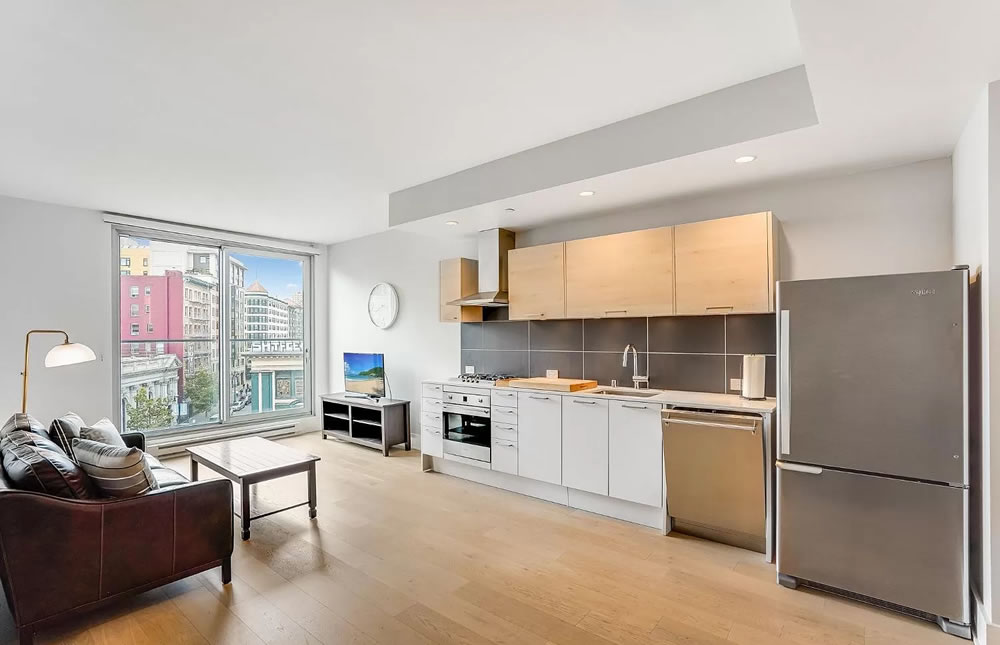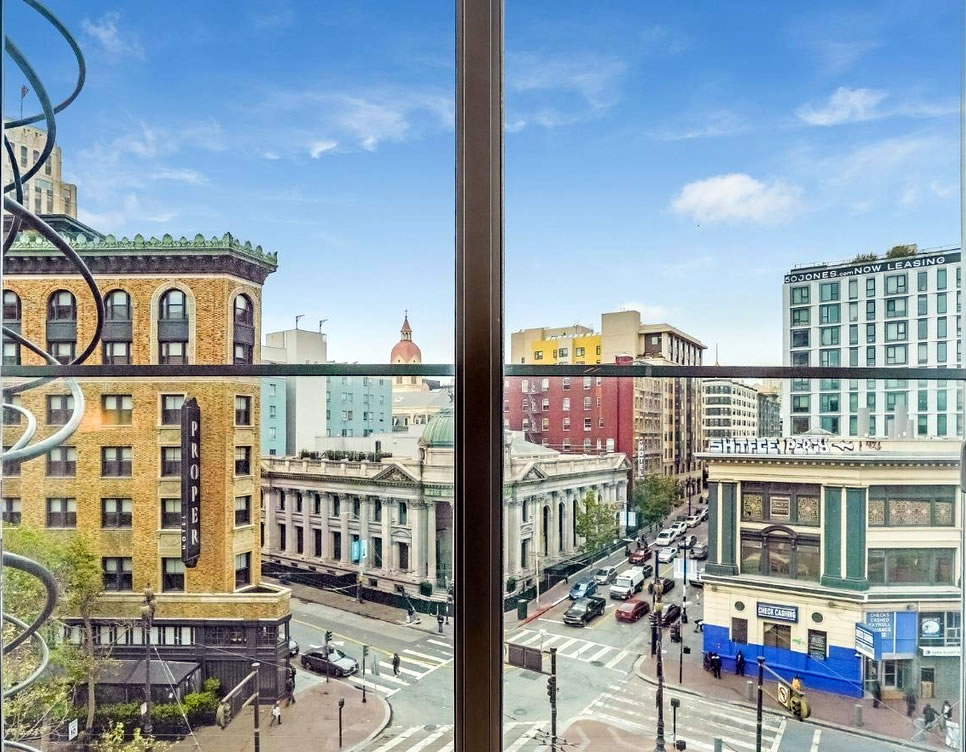Speaking of significantly sub-2018 pricing, but at the other end of the market, the one-bedroom, one-bath unit #606 at 1075 Market Street (“Stage 1075”) measures 672 square feet, with an open floor plan and (near) floor-to-ceiling windows that overlook Proper and the landmark Hibernia Bank.
The building (“San Francisco’s newest tech/hub location”) has a lobby attendant, virtual doorman, and an enviable rooftop deck with multiple fire pits, lounge seating, a barbeque and a dog run with a hose.
And having sold for a comp-setting $882,000 or roughly $1,313 per square foot in October of 2018, having been priced at $967,000 or $1,439 per foot by the sales office in 2017, 1075 Market Street #606 returned to the market listed for $749,000 last month and was just reduced to $670,000, a sale at which would represent a $212,000 or 24 percent drop in value from the fourth quarter of 2018 with monthly HOA dues of $738 for those running the numbers at home.










Gotta say, if some poor kid bought this trying to be close to work and public transport with hopes for that neighborhood and now has to sell at huge loss while everywhere he/she might have to move to (suburbs/SFH for family? Austin?) with higher (but admittedly softening) prices, they really caught the wrong end of both trends.
While there are many words to describe a kid who pays (almost) $900K for a condo, “poor” doesn’t seem to be one of them
Don’t worry. It was a very experienced lawyer.
That part of downtown is a disaster. The drug tourism filed by cartel soldiers and our insanely lax approach to law enforcement, paired with the healthright360/Urban Alchemy people and their injection tent has made it really really bad.
Tenderloin resident here – Urban Alchemy has drastically improved the area and those of us who live here truly appreciate them. Please do not mock the hard work of the individuals who are actually doing something for our community.
We are not talking about the Tenderloin. This is mid Market.
Urban Alchemy…the city are paying money to keep these folks out of trouble but let’s not pretend they actually do anything. Raise your expectations.
The thing is, it could very well be true that “Urban Alchemy has drastically improved the area and those of us who live here truly appreciate them” and that the existence of the injection tent is contributing to a marginal decrease in the selling price of owner-occupied properties near it since it went online late last year/early this year.
Both those statements could be true at the same time if the majority of residents in the area who think the injection tent is an improvement are renters and whose opinions don’t move the market for condos in the neighborhood. Similarly, if the people in the market for condos for whatever reason share the opinion that the injection tent is something they do not want to pay money to live around, their opinions will in some marginal way depress the selling price of condos near said tent. It would be very interesting to me if some econometrics expert could come up with a data analysis technique for identifying what amount that marginal decrease is, or even showing it doesn’t exist. Either of those would be a spectacular finding.
And I don’t think the (small) geographical difference between the Tenderloin and mid Market really matters in this case, does it? From In San Francisco’s dystopian Tenderloin, the city goes rogue to slow drug overdoses, ninth ‘graph:
That was an opinion piece, but the number given was from an authoritative source. Twenty-five people per hour of the workday? Sounds to me like The facility attracts “clients” from all over the vicinity.
And btw, the people later on in this thread talking about how SF needs a strong leader overlook things like the declaration of the State of Emergency in the Tenderloin that Breed used to cut through the bureaucracy that get in the way of decisive action, such as opening the safe injection site (which to be honest, is plainly illegal). That’s what strong leaders do. I think the people complaining about Breed here just disagree with her policies and would like her to act in accordance with their policy preferences, which mostly are about championing the interests of the local petty and moyenne bourgeoisie (“the developer of the Tennis Club site…couldn’t attract an anchor tenant…they tried…bio-tech space but the City said no”). But that does not make a Mayor a strong (or weak) leader.
A $670k condo is “entry level”? Unit #504 at the Book Concern Building, located right around the corner from here and asking $468k at time of this post, up only 14% since the tail end of 2006, is “entry level”.
This was purchased during the period of irrational exuberance (pre-Covid) that led many purchasers to pay over the top prices for downtown properties. A bet on rapid appreciation in the few years subsequent to the purchase. Investors in particular paid dearly for condos with the idea of flipping them in 3, 4 or 5 years. These investors were willing to put up with monthly negative cash flow for several years which expected appreciation would dwarf. Price discovery is underway and the absence of investors (who made up a significant portion of pre-Covid purchasers) this time around will put downward pressure on prices.
Office building price discovery is now underway also. 455 Market was just put on the market for close to $750 per square foot ($280 million). That’s below the $900 per square foot the building would have fetched pre-pandemic according to the SFBT. The tower consists of class A office space and if UBS can
sell it a new benchmark will be set for downtown office towers. It may well presage a significant drop in rents for class A office space which so far has not occurred.
You’ve been talking about SF’s pending collapse every day for about 15 years now.
For several years now I have found Dave (Seattle Dude) to be one of this site’s most interesting and insightful posters, and I admire his ability to shrug off the constant little insults other posters always throw at him.
I work in institutional CRE, and he is spot on in this case. The SF office market is about to feel more pain than most realize, with a market value decline from today’s levels for Class A space of 10-30% very possible. But, that will take some time to play out. As someone who just “returned to the office” after two years away, the amount of foot traffic downtown is about 33% of what it used to be. 7 out of every 10 lunch spots are closed, and the vacancy rate of street-level retail along market is shockingly high (probably 60% between the Ferry Building and mid-Market). Once appraisers can no longer claim “a lack of transparency,” and a low bar is set through a Class A sale, the pain will begin. No other major market is poised to suffer quite as much as SF, for a variety of reasons. And I’m happy to say I only have to deal with the filth and mental illness about 33% of the work week.
I wonder what this unit would rent for. $3000? (I may be way off)
The enviable roof deck with a “dog run with a hose” is necessary given that’s one of the worst blocks in the city. Too rough to take your dog out for a pee late at night. Roof must smell as bad as the street!
i prefer MORE THAN instead of OVER — they are synonyms. OVER is the opposite of UNDER (not less than)
I’m afraid we are witnessing the demise of a beautiful and walk-able city. I blame London Breed for this. She and her health department instilled fear in the population. If she were to insist the 36K city employees return to the office tomorrow it could be the beginning of the rebirth of the city. I somehow doubt she has the guts to do that. So we watch San Francisco slowly fade away.
Read the story (name link) for how the SF Cron sees the demise of the city.
Excellent analysis. Bottom line, as related to downtown, downtown will not against be the jobs center it was. Probably by a significant amount. Meaning the slew of businesses that lined downtown streets are/will no longer be needed so the article is right about converting some retail space to residential use.
As to tax implications, if 455 Market ends up selling for asking (about 15% below its pre-pandemic value) a new baseline for downtown Class A will be set. The property tax revenue could drop by a huge amount in coming years as owners seek to reduce their assessments based on a new, lower, benchmark.
Unfortunately, City officials seem clueless as to the starkness of the situation. At a time when research space is in huge demand in the Bay Area no mov has been made to specially make an effort to lure these jobs to SF. Instead, the developer of the Tennis Club site realized they couldn’t attract an anchor tenant and so could not build. They tried to pivot by turning the project into bio-tech space but the City said no. The Tennis Club entitlement has quietly been put on the market.
Breed is not a strong leader by any stretch. The leadership needed now as SF faces a “demise” is a Guiliani type mayor and specifically his leadership in turning NYC around.
Not that I would ever question the hallowed Chronicle, but the one number that seems most relevant – indeed it might be seen as a proxy for all other measures of “health” – the sales tax figure, not only wasn’t down as much as the others, but the figure was from 2021 (i.e. a full year ago when recovery was just beginning).
Translation: this was a nice start, but maybe we should turn it over to someone who isn’t so predispose to turning out clickbait.
Dave, serious question: when did SF last have a strong leader? (and when did it have a sane board of supes?) I moved there late in Willie Brown’s last term, visited regularly for decades prior but resided there too late to develop a firsthand sense of how the city was run.
I can’t comment on whether Willie Brown was strong, or just savvy as all get out, but I’ve seen no strength, and less competence in city leadership since.
Regionally, Jerry Brown showed an abundance of both qualities as Gov, but locally? SF has been run by children for as long as I’ve been here. One could infer that Breed was even more small-time when her literal first order of business was asking to get her brother out of prison just because “Now I’m mayor.”
God help that once (and hopefully future) great city. (I left for Marin 3 years ago.)
I agree 100%. Willie Brown had many faults, but he could get things done. I did not always agree with what he was doing, but he was very competent.
Ever since he left, we have had generally weak mayors.
First term Willie had city-wide supervisors, second term saw a good amount of incumbants re-elected. After that the neighborhood specific voting really showed up.
Regardless of the supervisors, Brown knew how to get things done. (And again, there was much I did not like about his policies. In some ways, I wish he had been less effective.)
Commuting to the office is a waste of valuable human lives and also is very harmful for the environment. I encourage you to see the positives rather than focusing on the “negatives,” such as an overpriced workweek sandwich spot forced out of business, or the lazy union slobs at BART feeling some pain in their subsidized jobs program.
I know. Working from home is fantastic.
Everyone loves to hate on techies, but what your linked article proves is that the tech industry drives the San Francisco economy, and without it, the city is going to be a devastating place.
Wrong, “techies” drove out any remaining blue collar flavor left in SF, ruined housing affordability, and made the city into an unlivable dork fest. That fool Ed Lee gave Twitter an unnecessary tax break, too bad we got a worse fool in the name of London Breed. There is very little positive in SF’s future.
the lack of new housing through NIMBYs and terrible anti-housing politicians/processes, ruined SF affordability.
Jimbo, you seem to offer up the one-note Yimby/Build Baby Build trope (OK, I guess it’s two notes) on repeat here, stating that lack of density, not tech, is the real factor killing affordability (to which I say, “Ha! Tell that to someone in Austin!”)
Could it occur to you that not everyone in every part of SF wants to see the city densified, and that this is actually OK? What debt does SF have to anyone to build a blade-runner-esque level of density? The country is vast. The surrounding suburbs are vast, the freeway corridors in the East Bay are vast. There are so many places where density can be built. Why must it be within the 7×7?
Where should all this building in SF happen and again, why exactly should it happen? To me, the argument that this would fix affordability is on the spectrum with the argument that if rents were cut in half citywide, there’d be substantially fewer homeless on SF’s streets. Hard not to be skeptical when facts on the ground are considered.
The San Francisco economy can and will adjust. Isn’t the most tired and well worn trope in these comment threads newly-minted agents who have arrived here from elsewhere to seek their fortune selling real estate posting “cities are always changing”?
Well within the adult lifetimes of most of the commenters in this thread, much less living memory, The City’s economy did not revolve around tech companies having large numbers of their employees living here and commuting in to spend money in and on local businesspeople’s stores. It can go back to being that way, and this will not spell the demise of a walkable city. It might be less expensive for folks already here to live, though.
Yes I don’t disagree with you, and the SF economy needs to diversify badly was the main point of my post. Tech is an incredibly important economic sector in the 21st century though, and shouldn’t be shrugged off. But it also shouldn’t come at the cost of other sectors. I agree with poster above that pushing out blue collar jobs, artists, musicians, and long time residents definitely hurt the city as a cultural center and all around fun, lively place. Not because of techies themselves (they exist in every city), but because the real estate values skyrocketed so high that it pushed everyone out. This is not a fault of techies, but of the city leaders and management. And ultimately, the voters who put those people in charge.
I hope the city can adapt to the post-Covid world and rise up better than ever.
How do you know that people are “newly minted” agent, and are from elsewhere? do you have an alias filter?
the housing price growth (decreased affordability) of other non-tech cities has outpaced SF over the past 10 yrs. the key difference is our lack of building adequate housing to accomondate economic population growth
WFH is fantastic but don’t pretend it’s that environmental. Population density is environmental, and WFH is only going to encourage sprawl.
“Block, the fintech formerly known as Square, will not renew its lease for nearly 470,000 square feet at 1455 Market St. in San Francisco’s struggling Mid-Market neighborhood, the company said Wednesday.”
This does no bode well for Mid-Market or the city in general. Weekly this news is like death by a thousand cuts for San Francisco.
That same article noted that Twitter is speculated to be leaving as well. These tech jobs were the driver of overly priced condos in the downtown area. The parcel F developer renegotiated their agreement with SF to reduce penalties for not having completed the tower by EOY 2023. The goal now is by EOY 2027. Given everything it’s not a given this project will actually move forward – 2027 or not.
ive heard that Dolby is also getting a lot of pushback from workers to coming back, even though they have an older, less mobile workforce. Dolby is offering personal escorts to public transportation and to workers cars due to safety of workers being the number 1 concern. No one wants to work in the cesspool of drugs and filth and misery that is mid-market. the twitter tax break experiment was a good one to try to revitalzie area, but unfortunately it failed. the city has to toughen its stance on lawlessness or people will not want to come back to work mid-market or downtown.
I thought Square moved to Oakland? This could actually be a great Zero-Sum story.
That was Uber
to clarify, for a while. Uber HQ in Mission Bay these days IIRC
No, Uber sold the building to Square.
The latter never actually said it would be their HQ, but that was several downsizings aso.
Wrong. If “overly priced condos in the downtown area” actually get sold for reduced prices in the short term and that lowers — in a meaningful way — the cost of living in San Francisco to a point where residents other than the small segment of folks working for a relatively small number of tech firms can afford them, then that does bode well for the downtown area and The City in general.
UPDATE: Mid-Market Condo Resells for 29 Percent Below its 2018 Price